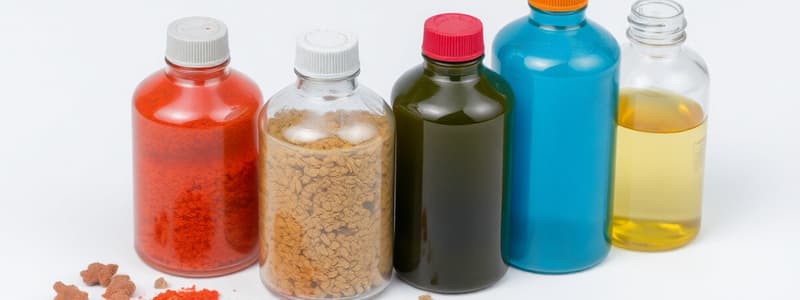Podcast
Questions and Answers
What are the key differences between physical, chemical, and biological determinations in measuring water and soil pollutants?
What are the key differences between physical, chemical, and biological determinations in measuring water and soil pollutants?
Physical determinations focus on the observable characteristics, chemical determinations analyze the chemical composition, and biological determinations assess the presence of living organisms or pathogens.
Explain how noise pollution from industrial sources differs from community noise sources and the implications for measurement.
Explain how noise pollution from industrial sources differs from community noise sources and the implications for measurement.
Industrial noise sources typically produce constant and high-intensity sounds, while community noise sources are variable and often related to activities like traffic or events. This requires different measurement techniques for accurate assessment.
Describe the role of environmental toxicology in assessing the impact of pollutants on human health.
Describe the role of environmental toxicology in assessing the impact of pollutants on human health.
Environmental toxicology studies the effects of chemical pollutants on biological systems, helping to understand the risks they pose to human health and the environment.
Identify the major pollutants that can arise from solid wastes and their potential effects on soil and water quality.
Identify the major pollutants that can arise from solid wastes and their potential effects on soil and water quality.
Discuss the methods used in measuring air pollutants and the significance of these measurements in environmental health.
Discuss the methods used in measuring air pollutants and the significance of these measurements in environmental health.
Flashcards
Air pollutant
Air pollutant
A harmful substance in the air that can affect human health, the environment, and climate. Examples include carbon monoxide, sulfur dioxide, and ozone.
Water pollutant
Water pollutant
A substance that contaminates water and makes it harmful for drinking, swimming, or supporting aquatic life.
Soil pollutant
Soil pollutant
A substance that contaminates the soil and makes it less fertile or unsuitable for plant growth.
Noise pollution
Noise pollution
Signup and view all the flashcards
Environmental toxicology
Environmental toxicology
Signup and view all the flashcards
Study Notes
Air Pollutants
- Measurement of air pollutants is a crucial aspect of environmental monitoring.
Water and Soil Pollutants
- Pathogens: Microscopic organisms causing disease.
- Solid Wastes: Discarded materials needing proper disposal.
Environmental Toxicology
- Study of harmful effects of toxic substances on living organisms.
Noise Pollution
- Community Noise Sources: Sources of noise in residential areas.
- Industrial Noise Sources: Sources of noise from factories and industries.
- Noise Pollution Measurements: Methods for quantifying noise levels.
Measurement of Water/Soil Pollutants
- Physical Determinations: Physical properties analysis of water and soil pollutants.
- Chemical Determinations: Evaluating chemical composition of water and soil pollutants.
- Biological Determinations: Analysing biological impacts of pollutants on organisms.
Studying That Suits You
Use AI to generate personalized quizzes and flashcards to suit your learning preferences.




